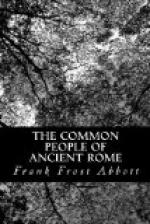The two theories of the realistic romance which we have been discussing assume that it is a parody of some anterior form of literature, and that this fact accounts for the appearance of the satirical or cynical element in it. Other students of literary history, however, think that this characteristic was brought over directly from the Milesian tale[84] or the Menippean satire.[85] To how many different kinds of stories the term “Milesian tale” was applied by the ancients is a matter of dispute, but the existence of the short story before the time of Petronius is beyond question. Indeed we find specimens of it. In its commonest form it presented a single episode of every-day life. It brought out some human weakness or foible. Very often it was a story of illicit love. Its philosophy of life was: No man’s honesty and no woman’s virtue are unassailable. In all these respects, save in the fact that it presents one episode only, it resembles the Satirae of Petronius. At least two stories of this type are to be found in the extant fragments of the novel of Petronius. One of them is related as a well-known tale by the poet Eumolpus, and the other is told by him as a personal experience. More than a dozen of them are imbedded in the novel of Apuleius, the Metamorphoses, and modern specimens of them are to be seen in Boccaccio and in Chaucer. In fact they are popular from the twelfth century down to the eighteenth. Long before the time of Petronius they occur sporadically in literature. A good specimen, for instance, is found in a letter commonly attributed to AEschines in the fourth century B.C. As early as the first century before Christ collections of them had been made and translated into Latin. This development suggests an interesting possible origin of the realistic romance. In such collections as those just mentioned of the first century B.C., the central figures were different in the different stories, as is the case, for instance, in the Canterbury Tales. Such an original writer as Petronius was may well have thought of connecting these different episodes by making them the experiences of a single individual. The Encolpius of Petronius would in that case be in a way an ancient Don Juan. If we compare the Arabian Nights with one of the groups of stories found in the Romances of the Round Table, we can see what this step forward would mean. The tales which bear the title of the Arabian Nights all have the same general setting and the same general treatment, and they are put in the mouth of the same story-teller. The Lancelot group of Round Table stories, however, shows a nearer approach to unity since the stories in it concern the same person, and have a common ultimate purpose, even if it is vague. When this point had been reached the realistic romance would have made its appearance. We have been thinking of the realistic novel as being made up of a series of Milesian tales. We may conceive of it, however, as an expanded Milesian tale, just as scholars are coming to think of the epic as growing out of a single hero-song, rather than as resulting from the union of several such songs.




